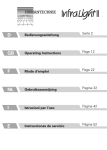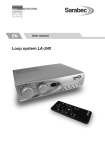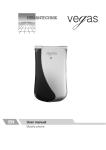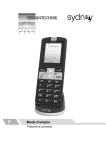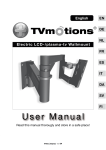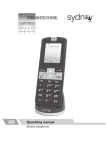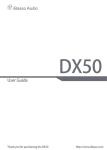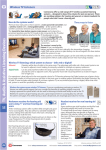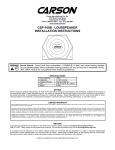Download Operating Instructions
Transcript
GB Operating Instructions Quick Setup 1. 2. 3. 4. 5. 6. 7. 8. 9. 10. Check contents of package. Place transmitter near TV or sound source. Connect audio leads between TV and transmitter. Connect power supply to transmitter and plug into mains socket. Place receiver in transmitter charging cradle. Leave receiver in cradle for 14 hours for an initial charge. Switch on TV. Take receiver from charging cradle and wear the receiver. The headset receiver switches on automatically when you wear it. The Neckloop receiver has an on/off switch on the rear. Make sure there are no obstructions between you and the transmitter. Adjust the receiver volume to your needs and enjoy your favourite programmes. Introduction Thank you for purchasing the InfraLight Wireless listening system. The system allows you to listen more clearly to your TV, Radio or HiFi without any need for trailing wires. It uses Infrared technology, similar to remote controls, to transmit sound from your TV or other audio equipment to a headset or neckloop receiver. Before using the system, please read these instructions to benefit from all the capabilities of the system and give you many hours of reliable listening performance. The system consists of two parts; a transmitter to pick up sound from your TV or HiFi and a receiver powered by a rechargeable battery. A headset receiver is for people without a hearing aid and a neckloop receiver is for people who want to use the ‘T’ facility of their hearing aid. The system is delivered with a connection kit to allow you to connect to most modern audio equipment. An optional microphone can be used where direct connection is not possible. More than one listener can use the same transmitter. Receivers of either type can be used at the same time. The system can charge up to three batteries at the same time. 2 Safety Precautions This product is designed for hard of hearing people and can produce loud sound levels. Listening to uncomfortable sound levels for long periods could affect your hearing. The manufacturer cannot be held responsible for damage which is caused by not using the System in compliance with these safety precautions. • • • • • • Do not open the system parts at any time; NO user serviceable parts can be found inside. Disconnect the power supply before making connections to the system. Do not expose the system parts and accessories to rain or any other source of moisture. Ensure that there is enough room around the transmitter for ventilation. Do not cover the ventilation holes of the transmitter. Do not place the system components close to sources of heat, such as radiators. Cleaning Should cleaning be necessary ONLY use a soft damp cloth. Removable ear pieces may be cleaned separately but MUST be completely dry before replacing. Replace damaged ear pieces with new ones. 3 Transmitter Front view 1 - Charging socket 2 - Charging Cradle Rear view 3 - Power Supply 5 - Right/Left Line Input sockets 4a-Mono 4b-Stereo 6 - Microphone Socket Operating Range The diagram indicates the operating range. Reception will be cut off if the receiver is outside this area, 12m max. from the transmitter. 4 Setting up Place the transmitter in a suitable position near to your TV or HiFi. Make sure that the front is placed so that it can be seen by anyone who wants to receive infrared signals. 5 To obtain the best quality sound through your system use the red/white RCA phono connectors on the transmitter with the lead supplied to directly connect to your TV. If your TV or HiFi uses similar red/white RCA phono connectors to output sound then connect to these. You may need to refer to instructions for TV to configure the sockets to provide sound output if you get no sound from them. If your TV does not use RCA phono connectors to output sound then you could use the SCART or jack adaptors accordingly to suit your equipment. If you use the jack adaptor you may find that using a headphone socket may turn off internal speakers for other users. An optional microphone can be used to pick up the sound from your TV, allow people to speak to you through the system or to monitor other sounds e.g. telephone or door bell. Mono/Stereo switch. Normally set to “stereo”. If you connect to a mono audio source then switch to “mono” otherwise sound will only be heard in one ear piece. Plug the power supply into the transmitter and a mains socket. Place receiver in charging cradle and allow the batteries to charge for 14 hours before first use. Rechargeable Batteries The system only uses purpose-made batteries for the receivers. The system is supplied with one battery. Additional batteries may be purchased separately. This may be found in a packet or installed in the receiver. Blanking pieces are inserted in the charging sockets of the transmitter to prevent damage to the transmitter; these may be removed to charge one or two spare batteries. The blanking piece may look like a battery but it has no metal contacts. 6 Operation Switch on your TV or HiFi and adjust the volume for other members of the household. Your listening level can be set by the volume control on your receiver. Make sure that the receiver can see the transmitter; the “line of sight” should not be obstructed. The system will cover a room up to 12 metres long. Before wearing the receiver adjust its’ volume control to minimum. Receivers should be worn so that the InfraLight logo faces towards the transmitter. The transmitter power should not be switched off otherwise the batteries may not be fully charged when required. Headset receiver 7 - Volume control 8 - Rechargeable battery Open the arms by holding them at the ear tips and place them in your ears. There is no on/off switch, the headset switches on automatically when worn; you may hear a click as the arms are opened. Adjust the volume to suit your hearing. When finished listening; the receiver will automatically switch off when taken off. Place the receiver in the charging cradle. 7 Neck Loop receiver 9 - Rechargeable Battery 10 - Loop Safety break 11 - Volume Control 12 - Auxiliary Jack Socket Switch on the receiver with the switch on the back of the receiver. Place the neck loop around your neck with the switch side towards you. The neck loop has a safety break in it; this should be connected together when in use. You can use this feature to make wearing or taking off the receiver easier. Switch your hearing aid to the ‘T’ position. Adjust the volume control on the receiver to suit your hearing; you may also need to alter the volume of your hearing aid. When finished listening; switch off the receiver on the back of the receiver and place the receiver in the charging cradle. The neck loop receiver can also be used as a universal receiver by using the 3.5mm stereo jack socket on the base of the receiver. Any suitable listening device with a 3.5mm stereo plug may be used. E.g. - Headphones - Under chin headset - Earphones - Neck Loop - Ear Hooks – mono or stereo - Hearing aid direct input leads Plugging in a listening device will cut off the integral neck loop. Removing the external listening device will return signal to the integral neck loop. 8 Rechargeable batteries and charging You can expect up to 10 hours listening from a fully charged battery. However this may be reduced according to the volume setting of the receiver and the type of programme being watched. If, whilst listening, the sound stops or the sound quality becomes noisy or distorted the receiver battery has become discharged and will need charging before further use. You may wish to purchase a second battery to increase your listening time. A second or third battery may be placed in either of the charging sockets on the sides of the transmitter. These extra batteries can be charged whilst listening. If your battery becomes discharged whilst listening you can simply swap batteries to continue listening. A flat battery will be recharged in about 14 hours. Red indicator lights will show in the front of the transmitter if a battery is being charged. Each light corresponds to a charging position; one for the receiver cradle and one for each of the charging sockets. NOTE: If using the receiver cradle to charge a battery please ensure that the receiver is placed centrally such that the charging light is lit otherwise charging will NOT happen. When using the side charging sockets please ensure the batteries are pushed in until the corresponding light is lit. The mains power to the transmitter must be left on for the batteries to recharge. The charging control lights show red at all times when charging and do not change colour. They only indicate the presence of a battery in the charging position and do not indicate that a battery is being charged. Batteries normally take about 14 hours to reach full charge. Other dim lights may show for the infrared system; this is normal operation. Charging control lights 9 Maximising Battery life Each battery pack contains 2 NiMH rechargeable cells. All rechargeable batteries have a limited life and do not last for ever. Full battery capacity may not be reached until 4-5 charge/discharge cycles have occurred. These battery packs are designed to be recharged at least 500 times. If you can fully discharge the battery through use before recharging then you will get the maximum life from the battery. If partially charged batteries are recharged this will shorten the overall life of the battery. All rechargeable batteries degrade over time which means that their capacity will naturally decrease with regular use. If you are unsure whether a receiver battery is fully discharged before placing in the charging cradle then use the receiver until the sound disappears or becomes distorted then either recharge the battery pack or, if available, simply swap the battery pack for a fully charged spare battery from the transmitter charging socket. Remember to switch the power off to the transmitter and remove the batteries from transmitter and receivers when not using the system for a long period of time. Changing Batteries Warning: The rechargeable battery packs only go into a receiver or transmitter in one direction and slide in and out quite easily. They do NOT require force to be inserted into the transmitter or receiver. If force is used it will damage the socket. 10 Volume Control Cover A clear plastic cover is supplied to accidentally prevent changing the volume control. To use this remove the two rubber plugs and clip the plastic cover in place. This can protect the receiver from dust and liquids from coming into contact with the volume control. Balance Control If you want to change the balance between the left and right ear on the headset receiver use the small screw control on the rear of the receiver to adjust this. A suitable screwdriver is supplied with the system. +/- 40dB control of the balance is available. 11 Problems and Cures Symptom Recharging control lights do not show when batteries or receiver are placed into the transmitter. Cause & Solution Check that the transmitter power supply is correctly connected to the transmitter and mains power socket. Middle recharging control light does not show when a receiver is placed in the charging cradle. No contact is made between the charging contacts and the receiver. Check that the receiver is correctly placed into the cradle. Check that a battery is correctly inserted into the receiver. Side recharging lights do not show when a battery is placed in the side charging compartments No contact is made between the charging contacts and the battery. Check that a battery is correctly inserted into the transmitter. No sound is heard from the receiver Transmitter is not correctly connected to TV/HiFi etc. TV/HiFi is not turned on/output not switched on, refer to your other equipment instructions. Check battery is placed correctly in receiver. Replace battery with a fully charged one. Poor or distorted sound Check “line of sight” to the transmitter is not obstructed Check the transmitter and receiver are within 12 metres Plasma TVs can cause Infrared disturbance you may need to change to another listening system. Replace battery with a fully charged one. Battery pack does not give expected operating time per charge Battery pack is not fully charged Battery pack has reached its’ recharging limit and needs replacement 12 Technical Specifications Modulation FM, Stereo & Mono Carrier frequency 2.3 / 2.8 MHz Frequency response 15 – 20kHz Distortion < 1% Signal to Noise Typ. 60dB Battery charging time ~ 14hours Battery capacity 180mAh Headset receiver Operating time per charge ~ 10hours Maximum volume SPL ~ 120dBA Weight 55g Neckloop receiver Operating time per charge ~ 10hours Weight 56g Transmitter Power consumption ~ 3.6VA Operating voltage 12 V DC Supply voltage 230V 50Hz Weight 172g 13 Humantechnik Service-Partner D Germany CH Switzerland F/B France Belgium NL Netherlands GB Great Britain Humantechnik GmbH Im Wörth 25 D-79576 Weil am Rhein Tel.: +49 (0) 76 21/ 9 56 89-0 Fax: +49 (0) 76 21/ 9 56 89-70 E-mail: [email protected] Humantechnik GHL AG Rastatterstrasse 9 CH-4057 Basel Tel.: +41 (0) 61/ 6 93 22 60 Fax: +41 (0) 61/ 6 93 22 61 E-mail: [email protected] SMS Audio Electronique Sàrl 173 rue du Général de Gaulle F-68440 Habsheim Tel.: +33 (0) 3 89/ 44 14 00 Fax: +33 (0) 3 89/ 44 62 13 E-mail: [email protected] Hoorexpert BV Gildenstraat 30 NL-4143 HS Leerdam Tel.: +31 (0) 3 45/ 63 23 93 Fax: +31 (0) 3 45/ 63 29 19 E-mail: [email protected] Sarabec Ltd 15 High Force Road GB-Middlesbrough TS2 1RH Tel.: +44 (0) 16 42/ 24 77 89 Fax: +44 (0) 16 42/ 23 08 27 E-mail: [email protected] For other service-partners in Europe please contact: Humantechnik Germany Tel.: +49 (0) 76 21/ 9 56 89-0 Fax:+49 (0) 76 21/ 9 56 89-70 Internet: www.humantechnik.com e-mail: [email protected] RM4017-3 · 0512

















